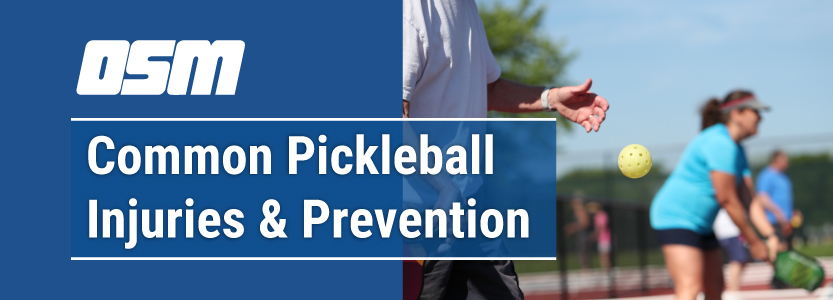Common Pickleball Injuries & Prevention
Article featured on Towson Orthopaedic Associates
Pickleball’s popularity had taken off since the pandemic with many participants surprised to learn the sport has been around for nearly 60 years. What is also surprising is the number of people getting hurt while playing.
The appeal of the sport is that it is low impact and easy to learn so it is attractive to the 55 and older population. However, because it requires quick movement and agility as well as balance and strength, injuries have been occurring within this population at a rapid rate.
Towson Orthopaedic Associates has asked some of our specialists to outline the types of injuries they are seeing and tips for injury prevention. We’ve broken down the tips by parts of the body most impacted by injury.
Knee Injuries
What types of knee injuries are you seeing?
Knee sprains, muscle strains – including quadriceps and hamstrings – and meniscal injuries are all common injuries in pickleball.
Players may also suffer flare-ups of their underlying arthritis.
How are these injuries best treated?
Knee sprains and muscle strains are typically treated RICE – rest, ice, compression and elevation. Anti-inflammatories (such as Advil, Ibuprofen, Aleve) can also be taken to help alleviate the pain.
Meniscal injuries are often treated similarly, but may also need an injection. Occasionally with persistently painful meniscal tears, minimally invasive (arthroscopic) surgery could be required.
Exacerbations of arthritis can also be treated with injections. When the arthritis has become severe and pain is not managed with the above strategies, a knee replacement may be recommended.
What can I do to avoid a knee injury?
Warming up and stretching is very important. Strengthening thigh muscles – including quadriceps, hamstrings – in addition to our hip musculature, can also help in protection of the joint.
When returning from an injury, occasionally a brace may be recommended to give the knee additional support and compression to avoid reinjury.
Hand, Wrist, Elbow & Shoulder Injuries
The Orthopedic & Sports Medicine Center of Oregon is an award-winning, board-certified orthopedic group located in downtown Portland Oregon. We utilize both surgical and nonsurgical means to treat musculoskeletal trauma, spine diseases, foot and ankle conditions, sports injuries, degenerative diseases, infections, tumors and congenital disorders.
Our mission is to return our patients back to pain-free mobility and full strength as quickly and painlessly as possible using both surgical and non-surgical orthopedic procedures.
Our expert physicians provide leading-edge, comprehensive care in the diagnosis and treatment of orthopedic conditions, including total joint replacement and sports medicine. We apply the latest state-of-the-art techniques in order to return our patients to their active lifestyle.
If you’re looking for compassionate, expert orthopedic and podiatric surgeons in Portland Oregon, contact OSM today.
Phone:
Address
17355 Lower Boones Ferry Rd Suite 100A
Lake Oswego, OR 97035
Hours
Monday–Friday
8:00am – 4:30pm



